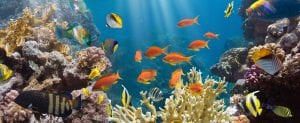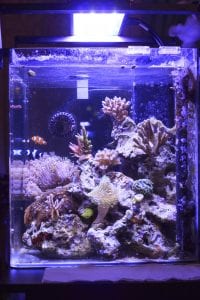
Everett Griner talks about the ornamental fish industry in today’s Agri View.
Ornamental Fish
From: University of Florida EDIS, IFAS Extension
The Ornamental Fish Trade: An Introduction with Perspectives for Responsible Aquarium Fish Ownership1
by E. J. Livengood and F.A. Chapman2
Introduction
 Aquarium keeping is amongst the most popular of hobbies with millions of enthusiasts worldwide. Together all countries of the European Union are the largest market for ornamental fish; however, the United States (US) is the single largest importer of ornamental fish in the world (FAO 1996-2005; Chapman 2000). Although exact figures on the value and trade of the ornamental fish industry do not exist, the value of ornamental fish and invertebrates imported into different countries worldwide is approximately $278 million US dollars (FAO 1996-2005). Pet industry surveys have estimated the aquarium industry worth over $1,000 million USD (e.g., Cato and Brown 2003; AAPMA 2005). Although most fish kept in aquariums are from freshwater, the acquisition of marine ornamental fish has greatly increased, popularized by children’s movies starring charismatic colorful fishes and other creatures. Recent advances in fish husbandry and aquarium equipment technology have further facilitated the hobby.
Aquarium keeping is amongst the most popular of hobbies with millions of enthusiasts worldwide. Together all countries of the European Union are the largest market for ornamental fish; however, the United States (US) is the single largest importer of ornamental fish in the world (FAO 1996-2005; Chapman 2000). Although exact figures on the value and trade of the ornamental fish industry do not exist, the value of ornamental fish and invertebrates imported into different countries worldwide is approximately $278 million US dollars (FAO 1996-2005). Pet industry surveys have estimated the aquarium industry worth over $1,000 million USD (e.g., Cato and Brown 2003; AAPMA 2005). Although most fish kept in aquariums are from freshwater, the acquisition of marine ornamental fish has greatly increased, popularized by children’s movies starring charismatic colorful fishes and other creatures. Recent advances in fish husbandry and aquarium equipment technology have further facilitated the hobby.
 There is a popular and rapidly expanding trend in the hobby to establish marine reef mini-ecosystems within the aquarium. Reef tanks are saltwater aquariums that house or center principally on invertebrates and minimize the number of fish. A typical reef tank makes use of live rock, both hard and soft corals, invertebrates such as crustaceans (e.g., crabs, hermit crabs, and shrimps), mollusks (e.g., snails, clams, and scallops), echinoderms (e.g., starfish, sand-dollars, and sea urchins), and of course, the endless variety of colorful fish. Consequently, the market value spent on many species of marine origin associated with the ornamental trade has greatly increased. For example, the retail value for a kilogram of coral reef fish destined for the aquarium trade may be worth $500 to $1,800 USD while a marine fish used for human consumption can be priced between $6 and $16.50 USD per kilogram (Cato and Brown 2003; Wabnitz et al. 2003).
There is a popular and rapidly expanding trend in the hobby to establish marine reef mini-ecosystems within the aquarium. Reef tanks are saltwater aquariums that house or center principally on invertebrates and minimize the number of fish. A typical reef tank makes use of live rock, both hard and soft corals, invertebrates such as crustaceans (e.g., crabs, hermit crabs, and shrimps), mollusks (e.g., snails, clams, and scallops), echinoderms (e.g., starfish, sand-dollars, and sea urchins), and of course, the endless variety of colorful fish. Consequently, the market value spent on many species of marine origin associated with the ornamental trade has greatly increased. For example, the retail value for a kilogram of coral reef fish destined for the aquarium trade may be worth $500 to $1,800 USD while a marine fish used for human consumption can be priced between $6 and $16.50 USD per kilogram (Cato and Brown 2003; Wabnitz et al. 2003).
 Box 1. Industry definition of ornamental fish and live rock
Box 1. Industry definition of ornamental fish and live rock
| Ornamental fish is often used as a generic term to describe aquatic animals kept in the aquarium hobby, including fishes, invertebrates such as corals, crustaceans (e.g., crabs, hermit crabs, shrimps), mollusks (e.g., snails, clams, scallops), and also live rock. Live rock is a general term for any type of rock encrusted with, and containing within its orifices, a wide variety of marine organisms including algae and colorful sessile invertebrates. Live rock serves as the principal biological and chemical filter in many marine-type tanks, and the encrusted organisms usually provide much of the background coloration in the tank. |
The vast array of animal species that make up the generic ‘ornamental aquarium fish trade’ is staggering. Around 2,000 species and millions of specimens are traded annually in the ornamental fish trade (Table 1). The number of species is almost equally divided between freshwater and saltwater species. However, the greatest volume or number of individuals in the trade, some 90-96%, are of freshwater origin and are produced in commercial aquaculture facilities (Chapman 1997; Cato and Brown 2003).
Table 1. Approximate number of fishes, corals, and other invertebrates in the ornamental (aquarium) trade. The majority of these species are collected from the wild. Only freshwater fish species are extensively farm-raised.
|
Ornamental Species |
Approximate Number of Species |
Principal Geographic Regions |
|
Fresh-, Salt-, and Brackish- Water Fishes |
1539 |
Southeast Asia, Americas, Africa, Indonesia |
|
Corals (hard and soft) |
102 |
Indo-Pacific, Caribbean, the Red Sea |
|
Invertebrates, other (e.g., shrimps, crabs, snails, starfish) |
293 |
Indo-Pacific, Caribbean, the Red Sea |
| Reference: various sources; principal, Cato, J.C., and C. L. Brown. 2003. Marine Ornamental Species: Collection, Culture, and Conservation. | ||
 An aquarium enthusiast can easily become overwhelmed by the endless variety of fish, invertebrates (including corals, anemones, mollusks), plants, and live rock available, and ultimately forget to consider their source and method of collection. Although many species in the hobby have been domesticated and are produced on farms, it is important to remember that many species are also collected from the wild and are not in limitless supply.
An aquarium enthusiast can easily become overwhelmed by the endless variety of fish, invertebrates (including corals, anemones, mollusks), plants, and live rock available, and ultimately forget to consider their source and method of collection. Although many species in the hobby have been domesticated and are produced on farms, it is important to remember that many species are also collected from the wild and are not in limitless supply.
To help promote resource sustainability, the potential aquarium owner should develop a basic understanding of the industry. Where did the species originate and were they wild-caught or farm-raised? Where did either practice occur, in what manner, and how were they handled during transport or before purchase? Local clubs, aquarium magazines, textbooks, Websites in the Internet, and some specialized retailers can often answer many of these questions. A conscientious and well-informed consumer can greatly help protect wild species and safeguard the natural environment. Sustainability of a wild fisheries resource is critical to maintenance of a healthy industry.
The collection and aquaculture of aquarium fish
Footnotes
- This document is FA124, one of a series of the Department of Fisheries and Aquatic Sciences, UF/IFAS Extension. First Published: May 2007. Reviewed JApril 2014. Please visit the EDIS website at http://edis.ifas.ufl.edu.
- E. J. Livengood is a graduate student, School of Natural Resources and Environment; and F.A. Chapman is an Associate Professor, Department of Fisheries and Aquatic Sciences; UF/IFAS Extension. Gainesville, FL 32611.









